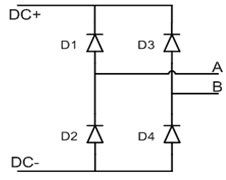Single Phase Diode Rectifier
Description of the Single Phase Diode Rectifier component in Schematic Editor

Schematic Block Diagram
A schematic block diagram of the Single Phase Diode Rectifier component, with its corresponding switch arrangement and naming is given in Figure 2
Weight of a Single Phase Diode Rectifier for real-time/VHIL simulation is 1.

Ports
- DC+ (electrical)
- DC side + port.
- DC- (electrical)
- DC side - port.
- A (electrical)
- AC side port
- B (electrical)
- AC side port
General(Tab)
- Optimization for square AC voltage
Optimization for square AC voltage is not used in TyphoonSim, and changing its value will not affect TyphoonSim simulation at all.
- When Optimization for square AC voltage is checked, the rectifier behavior is optimized for rapidly changing AC-side voltage, such as during a square signal.
Experimental(Tab)
- Rectifier optimization
Rectifier optimization is not used in TyphoonSim, and changing its value will not affect TyphoonSim simulation at all.
- When Rectifier optimization is checked, it optimizes the switching block to reduce the memory requirements of the model.
- The default state for Rectifier optimization property is enabled. In some cases, when the diode rectifier is in the same standard processing core as another converter based on half-bridge designs (such as Buck and Boost converters), the converter might not operate properly. In this scenario, optimization should be disabled to maintain the accuracy of the simulation.
- Predictive diode turn off
Predictive diode turn off is not ussed in TyphoonSim, and changing its value will not affect TyphoonSim simulation at all.
- Predictive diode turn off is available when Optimization for square AC voltage is not checked
If enabled, the current will be predicted for the next simulation step. If the predicted current is 0, the diode will turn off.
Extras (Tab)
The Extras tab gives you the opportunity to set Signal Access Management for the component.
Signal visibility is calculated based on the 'signal_access' property and whether or not
a parent component in its hierarchy is locked or not. Components that are not contained
within locked components expose their signals regardless of the 'signal_access'
property. The 'signal_access' property can have one of three values:
- Public - Components marked as public expose their signals on all levels.
- Protected - Components marked as protected will hide their signals to components outside of their first locked parent component.
- Inherit - Components marked as inherit will take the nearest parent 'signal_access' property value that is set to a value other than inherit.